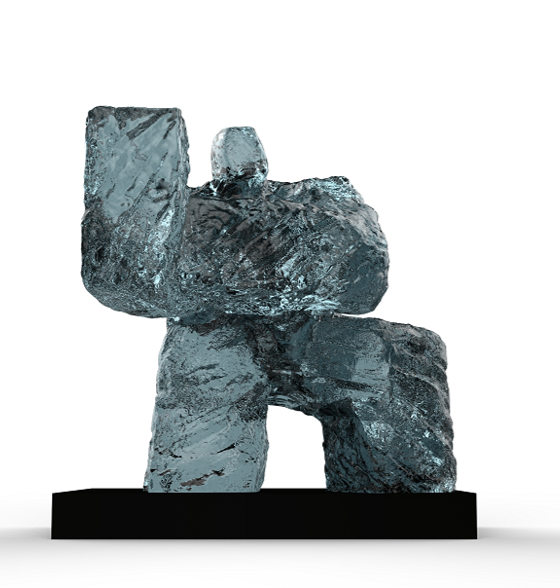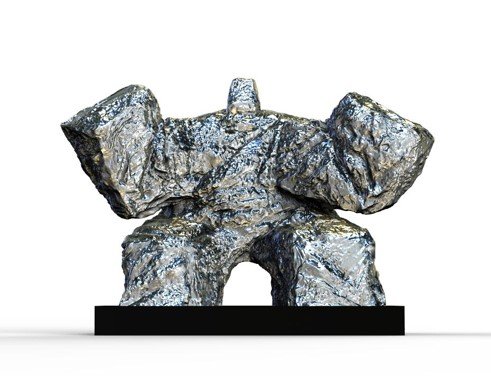The Road of Yi's Artistic Creation
It was an unexpected journey that drove Yi's passion for becoming a sculpture artist. Yi was born in a Chinese town called Shi Yan located in Central China. The city is known as the “Chinese Detroit” due to its booming car manufacturing industry since the 1970s. Like most of the adults in town, Yi’s parents devote their careers to the automotive-related industry. As a kid, Yi grew up surrounded by piles of car components and scrap car parts. Everyday Yi spends his time in the garage at home, storage in car factories when his parents are at work. Car components become the best toys that he ever has and shapes a big part of his childhood memory.
Unlike many young children in town, Yi enjoys spending time at home drawing. His mother sends him to drawing classes since he was 5 years old and this set up his path for the art industry. From age 5 to age 18, Yi received formal art training including sketch and oil painting, and he dreams to become a successful oil painter.
In his first year at the China Central Academy of Fine Arts majoring in Oil Painting, he decided to create a Transformer for himself. He has always had the idea deep down in his mind because he spent his childhood playing with scrap car parts and watching the Transformers series. In his first attempt, he uses the paper cutter and PVC foam to recreate a 2 meter Optimus Prime. Little did he know, the project he created to rationalize his childhood idea attracted great popularity within the community. A local cinema invited him to display his artwork in the lobby, and in turn he received 50 free movie tickets. This creation and the unintended outcome sparked his passion and confidence for more sculptures.
Transformers Series Sculptures 2008-2016
From 2008 to 2016, Yi had great success with his Transformers series sculptures in China. In this period, Yi created more than 30 Transformers series of sculptures. Through theTransformers series sculptures, people see Yi's talent and ability in the art field and insistence on his later independent artistic creation.
2008, the First PVC Foam Transformer
Yi's dream of creating sculpture began with this 2-meter-high PVC foam-made Transformers sculpture.
2009, Optimus Prime
It is 12 meters tall, fully metallic, and made from recycled truck parts. It was exhibited at the China National Stadium (Bird's Nest/Olympic Stadium) in 2010.
2010, Bumblebee
It is 3 meters tall and made from recycled auto parts. In 2011, it was exhibited in Beijing’s 798 Art District.
2014, Optimus Prime
Yi was invited by Audi to exhibit his sculpture with Audi’s latest supercar in Beijing.
Philosophy of Yi's Artworks
Yang Yi is graduated from the China Central Academy of Fine Arts. During the past few years, he has accomplished a series of works of art. His creation is meant to display an endeavor in face of the pressure of existence and imperfection. In other words, the reason why Yi has chosen to express their emotions and experiences towards the world he lives in such a way is that he has discovered some issues that he thinks are worth disclosing and must be disclosed, such as the surging inflation of the desire for material life and loss of humanism, the anomie of values caused by social transformations, especially the contradictions, loneliness, the anxiety over spiritual drifting and the feeling of having no destination he confronts living in such a world. He intends to display the numerous miserable realities existing in this age of mental confusion. In his visual probe into the cause of all these realities, he expresses his anxiety over the spirit ruins of the time he lives in and his pursuit and emancipation of the human race's new survival conditions.
Yi's style of art differs from any other modern style of art in its enormous size, which makes the spectators feel how small they are standing in front of their statues. In the meantime, he can sense the feeling of coldness given out by the materials used in the statues. By this means they intend to express the coldness the secular society imposes upon life and emphasize courageous confrontation and its potential impact on every life. Thus, the Transformer is not only a viewpoint but also an artistic representation for disclosing the absurdity of existence. While unfolding the miserable scenes of reality, it illuminates human care by displaying existence's misery. They display the bitterness of life and potential strength in store in life.
He is immersed in the miseries of the secular world with the self-tolerance of religious believers and the passion of reading the world, probing into human nature. When he is confronted with the miseries of the world, he has not ignored his responsibility and mission in despair, helplessness, and sorrow. Instead, he has been trying his best to search for a means for transformation in this age of mental confusion. Most of Yi's works of art attempt to prompt a way to free people from their miseries. While using transformers as the access point for their artistic language, he offers poetic interpretation out of the transformers: emancipation and freedom from mental pains. It is misery itself that helps to free themselves. This freedom is not one from the hardship of existence, but a positive attitude of responsibility and tolerance. This responsibility is actually an effective way to emancipate the human race itself. His art-craft is meant to bring back people's sentiment, so as to encourage people to recover their confidence in their ever-increasing confusion.
Pan Gongkai
Ex-president of China Central Academy of Fine Arts
Original Auto Parts Sculptures 2014-2019
Since 2014, Yi began to try to break away from the Transformers series and form his own unique style. During this period, some world-famous collectors and institutions began to collect Yi's sculptures.
Jackie Chan, Yi, and Jaycee Chan at Jackie's 60th birthday party.
Alan Gibbs and Yi
2012-2014, Drunkie Chan
Yi created Drunkie Chan in 2014. It is 6 meters tall and weighs 3 tons. It is made of recycled auto parts.
The inspiration for making this sculpture came from Jackie Chan's milestone movie Drunkie Master.
The traditional Chinese Gongfu and dragon culture influenced the shape of this sculpture, which Jackie Chan has made a permanent collection of on his art farm.
2013-2017, Marshall Alan
Marshall Alan is 4 meters high and weighs 2.4 tons. It is made of recycled auto parts, and world-class collector Alan Gibbs has collected it on his farm.
Marshall Alan took Yi over eight months to create, including sourcing components, making, and polishing. Before this long process, Yi took more than four years to think and design the structure, accessing relevant information and many interviews with Alan Gibbs. The sculpture records Alan Gibbs's achievements and honors through the cowboy's image.
Marshall Alan is part of the permanent collection of the world's largest private sculpture park: Gibbs Farm.
Yi and Alan’s family in Gibbs Farm
Having lived in New Zealand for more than ten years and traveled back and forth between the East and West, the concept of home has become vague to me. I have often found myself questioning, " Where is home?”
I was born in China, was educated there, and now live in New Zealand. I often have a sense of dislocation: a dual identity of East and West.
Since I have not adapted to either East or West, I am attracted to the boundary between things, where opposites meet. I am eager to balance art and science, East and West, rational and irrational, emotional and material, time and space. This juxtaposition has been a central theme throughout my art career and is reflected in my artwork.
When I started creating this sculpture series, ‘We Are One’, I had no idea how I would find my voice and how long my interest in the landscape, space, history, and time will stay with me. At the time, I did not realize that my creations were so closely infused with Aotearoa.
I am obsessed with describing the place where I live. For me, it is not just the physical space but also how the cultural context of my environment injects meaning into my landscape. I was eager to use my creations to express broader concepts related to my environment.
After my trip to the Waimakariri River, I was attracted to the waters of New Zealand. The glaciers and snow-capped mountains melted into rivers, which looked like light blue scarves etched into the earth. This made me feel the fluidity of water and the sense of closeness to the world. It also made me realize that water can be transformed into different forms: mist, liquid, and ice. I wanted to take the liquid form into a solid object and depict the transformation.
While looking upstream, I saw the mountain and was drawn to the boundary between it and the water—separate yet one!
In a similar vein, New Zealand’s many volcanoes and the Southern Alps have made a profound impact on me. These mountains are young and still in motion, and for me, there is hidden energy within this change. I am trying to use this transformational state to find a form of expression that does justice to its material state. The water and mountains of New Zealand are the beginning of my exploration, and I hope to give them a personality




A phalanx of seven arrowheads appeared on the earth, and this force cut the earth open. They are young lives nurtured by New Zealand, and this monumental sculpture group is not dedicated to anyone but to all who love New Zealand. When visitors walk into the installation, they will see their faces in the reflection of the stainless steel and, in so doing, form a connection with the sculptures: the purpose of this art series.
For me, it is a place where human nature, love and respect, East and West, New Zealand and I meet!




This is the final project for Yi fashion design studies in AUT. Yi managed to rebuild his past design concept by using innovative ways and pushing the boundaries of knowledge. The general idea was about creating a metallic feel for textile works, which reflected Yi's long-standing interest in general metallic elements as well as the pursuit to give recycled components a new life. The end creation was these dresses, which Yi wished could express feminine beauty from a different perspective.
































